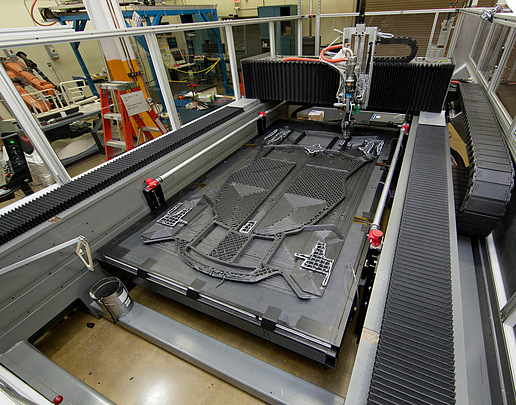 BAAM设备近期所取得的进展是打印珠尺寸变小了,这能够使打印成品的表面更为光滑。(请点击照片右上方箭头查看3D打印的Shelby Cobra的图片。)
BAAM设备近期所取得的进展是打印珠尺寸变小了,这能够使打印成品的表面更为光滑。(请点击照片右上方箭头查看3D打印的Shelby Cobra的图片。) 橡树岭国家实验室的研究人员们计划将3D打印的Shelby Cobra当做一个车轮上的实验室使用,利用它进一步研究机械制造领域的新技术,以及无线充电、电力电子学、混合系统设计等课题。
橡树岭国家实验室的研究人员们计划将3D打印的Shelby Cobra当做一个车轮上的实验室使用,利用它进一步研究机械制造领域的新技术,以及无线充电、电力电子学、混合系统设计等课题。
在底特律举行的2015年北美国际车展上,橡树岭国家实验室(ORNL)带来了一项集成了设计与运动元素的3D技术成果——通过这一快速传播的技术所复制的经典超跑Shelby Cobra。
这辆约重1400磅(600千克)的Shelby Cobra中有500磅(200千克)的部件是通过3D打印制造的,所使用的是含量为20%的碳纤维材料。
汽车的3D打印是在美国能源部橡树岭国家实验室(ORNL)完成的。ORNL有一台BAAM(大面积增材制造)设备,能够使用复合材料制造出大于1立方米(35立方英寸)的轻质而牢固的部件。
整个团队花了六周的时间设计、制造并组装Shelby,其中3D打印仅耗时24小时。所用的新BAAM系统是由ORNL与辛辛那提公司(Cincinnati Inc.)共同开发的,其打印速度比当今的工业用增材制造设备快500-1000倍。ORNL的研究员们认为,下一代增材制造设备惊人的制造速度为汽车行业,特别是交通工具的原型制造带来了新机遇。
“你甚至能够在几天至几周的时间内打印出一辆可以行驶的车辆”,ORNL制造系统研究团队负责人Lonnie Love说,“你还可以对所打印车辆的外形、装配与功能进行测试。我们快速创新的能力产生了巨大的变化。在交通运输领域的这种快速创新,甚至能够促使一个全新行业的诞生。”
据辛辛那提公司称,BAAM设备仍然处于原型阶段。近期取得的进展是打印珠尺寸更小了,这能够使成品的表面更为光滑。各种热塑塑料,包括纤维增强热塑塑料都可作为打印的原料使用。
打印完成后,由总部位于诺克斯维尔(knoxville)的TruDesign公司对Shelby进行打磨抛光,最后为北美国际车展呈现了这件外观一流的展品。
橡树岭的机械制造与交通工具研究员计划将3D打印而成的Shelby作为一个车轮上的实验室使用。该车的设计都旨在实现各个组件的“即插即用”,电池组与燃料电池技术、混合系统的设计、电力电子学、以及无线充电系统等,都能够在车辆上更加便利地搭载,使研究员可以快速尝试新的技术设想。
Shelby是Local Motors公司与ORNL合作完成的全3D打印车辆Strati的基础上的进步。BAAM设备为Strati制造了包括结构件在内的各种部件。Strati不但参加了Local Motors举办的比赛,还参展了11月在芝加哥举办的国际制造技术展(International Manufacturing Technology Show)。
制造Shelby所用的碳纤维增强ABS塑料由沙伯基础创新塑料(Sabic)提供,动力系统则来自雷诺捐赠的Twizzy,它的部分机械部件也是从Twizzy借用的。另外西门子的Solid Edge软件为Shelby的结构性设计提供了支持,Fifteen52则提供了车轮。
BAAM设备由直线电机驱动,目前的工作行程为2 x 4 x 0.87米(6.6 x 13.1 x 2.9英尺),挤出速率约为38磅/小时(17千克/小时)。它所能够打印的聚合物部件比现目前所使用的制造设备大10倍。研究人员计划将工作行程增加到2.4 x 6米(8 x 20英尺),并在Sabic的帮助下将挤出速率增加到100磅/小时(50千克/小时)。辛辛那提公司表示,另一项工作重点是增加Z轴行程,即所制造部件的可加工高度。
Oak Ridge National Laboratory (ORNL) put a very pretty and sporty face on its 3-D printing technology at the 2015 North American International Auto Show in Detroit, showing off a replica of a classic Shelby Cobra made via the rapidly propagating technology.
The approximately 1400-lb (600-kg) vehicle contains 500 lb (200 kg) of printed parts made of 20% carbon fiber.
The car was printed at the U.S. Department of Energy’s ORNL facility, which houses a so-called BAAM (Big Area Additive Manufacturing) machine that can produce lightweight and strong composite parts greater than 1 m³ (35 ft³) in size.
The team took six weeks to design, manufacture, and assemble the Shelby, including 24 h of print time. The new BAAM system, jointly developed by ORNL andCincinnati Inc., can print components 500 to 1000 times faster than today’s industrial additive machines. ORNL researchers say the speed of next-generation additive manufacturing offers new opportunities for the automotive industry, especially in prototyping vehicles.
“You can print out a working vehicle in a matter of days or weeks,” said Lonnie Love, Leader of ORNL's Manufacturing Systems Research group. “You can test it for form, fit, and function. Your ability to innovate quickly has radically changed. There’s a whole industry that could be built up around rapid innovation in transportation.”
The BAAM machine is still in the prototype stage, according to Cincinnati Inc. Recent improvements to it include a smaller print bead size, resulting in a smoother surface finish on the printed pieces. It uses a wide variety of thermoplastics and fiber-reinforced thermoplastics.
For the Shelby, subsequent work by Knoxville-based TruDesign produced a Class A automotive finish for the NAIAS showpiece.
The manufacturing and transportation researchers at Oak Ridge plan to use the 3-D printed Shelby as a laboratory on wheels. The car is designed to “plug and play” components such as battery and fuel-cell technologies, hybrid system designs, power electronics, and wireless charging systems, allowing researchers to easily and quickly test out new ideas.
The Shelby project builds on the successful completion of the Strati, a fully 3-D printed vehicle created through a collaboration between Local Motors and ORNL. The BAAM machine was used to make many of the various parts, including structural ones, for the Strati, which was designed as part of a contest held by Local Motors and built on site at November’s International Manufacturing Technology Show in Chicago.
Sabic Innovative Plastics supplied the carbon-fiber-reinforced ABS plastic. Renaultdonated the powertrain from the Twizzy, and some of the mechanical parts were “leveraged” from the same car. Siemens provided the Solid Edge software for the structural design elements and Fifteen52 provided customer wheels.
The linear-motor-driven BAAM machine currently has work envelope of 2 x 4 x 0.87 m (6.6 x 13.1 x 2.9 ft) and an extrusion rate of about 38 lb/h (17 kg/h). It prints polymer components up to 10 times larger than currently producible. Plans are to increase the work envelope to 2.4 x 6 m (8 x 20 ft) and, with Sabic, to increase the extrusion rate to 100 lb/h (50 kg/h). Another priority is increasing Z-axis travel (the working height for the part being built), according to Cincinnati Inc.
等级
打分
- 2分
- 4分
- 6分
- 8分
- 10分
平均分
